Spider-view: Marvel Super Heroes Secret Wars
Marvel's classic crossover event, though not flawless, remains a genuinely rewarding series over thirty years later
—by Nathan on July 10, 2020—
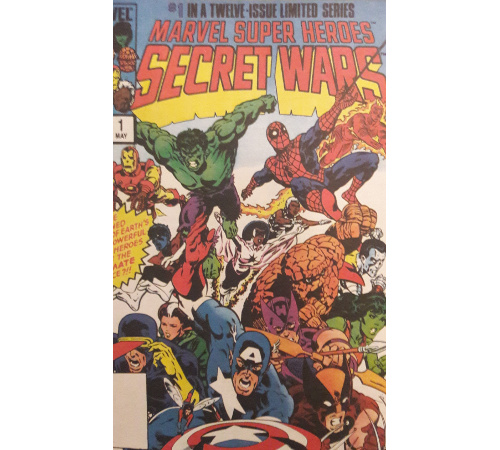
In June of 1982, Marvel published their first ever crossover event and limited series, Contest of Champions. Written by our good friend Bill Mantlo and illustrated by John Romita Jr., this three-issue series saw practically every one of Earth’s superhuman champions abducted by an alien being called the Grandmaster, with twenty-four of them set against one another in teams competing for pieces of a larger prize. The series starts off strong by pulling in dozens of heroes, from notable figures such as Spider-Man, Captain America, Iron Man, the Hulk, and Wolverine, to more obscure heroes like Shamrock, the Soviet Super Soldiers, Defensor, and Peregrine. A potentially entertaining idea very quickly turns repetitive, with teams duking it out in different climates for pieces of the prize. Cold War-era dialogue is scattered throughout--an Islamic superhuman clashes with an Israeli hero, people keep calling the Soviet characters “reds,” etc.--making for some awkwardly outdated exchanges. Blending together these bizarre verbal encounters with humdrum action and a mediocre story, Contest of Champions shows Marvel dipping their toes in the water, finding it too cold, and pulling back to find warmer waters.
I returned my copy of the trade paperback shortly after reading it.
Produced two years later, Marvel Super Heroes Secret Wars may not have been the first crossover event by Marvel but it set the standard for cross-company narratives that came after it. Simple yet enduring, Secret Wars feels like a true crossover, where characters actually interact and the story progresses nicely. But entertaining as it is, even Secret Wars isn’t perfect. We’ll explore both the fantastic and the flawed in today’s post, seeing how the series holds up over thirty years later.
Marvel Super Heroes Secret Wars
Writer: Jim Shooter
Pencilers: Mike Zeck (issues #1-3, #6-12), Bob Layton (issues #4-5)
Issues: Marvel Superheroes Secret Wars #1-12
Published: May 1984-April 1985
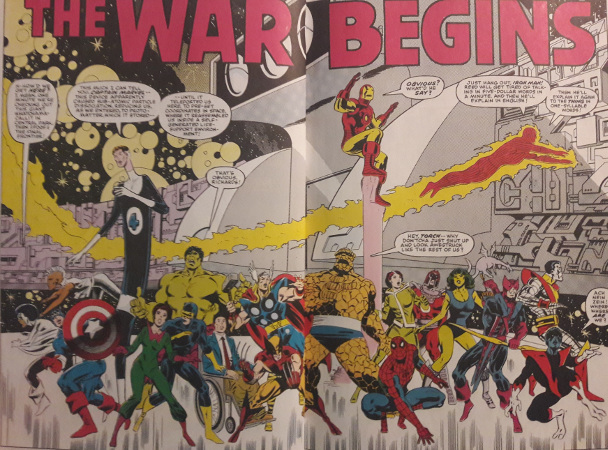
The story behind Secret Wars is well-known to Marvel fans: the series was developed to accompany a line of action figures produced by Mattel that was rather short-lived and featured characters, buildings, and vehicles never used in the comic series. Despite its playful origins, Secret Wars became a thing unto itself and, for a series intended to help sell children’s toys, has had surprising longevity in the Marvel Universe. An element or two from this series remains entrenched in comic book lore today, and it may surprise a few people to know that without the series, we would have never had Venom, Carnage, or any of their related characters, series, cartoons, or films.
Shooter, Zeck, and Layton craft a space opera of epic proportions: similar to Champions, Secret Wars starts with several heroes and villains plucked from Earth and stranded on a patchwork planet, “Battleworld,” cobbled together from various distant planets (including a suburb of Denver!). Brought together by a mysterious entity known as the Beyonder, the assembled heroes and villains are told to do battle, protagonists vs. antagonists, with one side promised wishes beyond their wildest dreams should they succeed. On one side, you’ve got a handful of Avengers, several X-Men, the three male members of the Fantastic Four, Spidey, the Hulk, and...Lockheed the Dragon?!? Okay. Representing the villains are some of earth’s fiercest foes, including Doctor Doom, Galactus, Kang the Conquerer, Ultron, Doctor Octopus, the Enchantress, the Absorbing Man, the Wrecking Crew, and the Lizard. Magneto, that arch-fiend, is cleverly included on the heroes’ side of the playing field, included by Shooter because, in Magneto’s eyes, he doesn’t fight for the same petty, selfish reasons the other villains do; he wants justice for the entire mutant race and views himself and his intentions through a nobler lens.
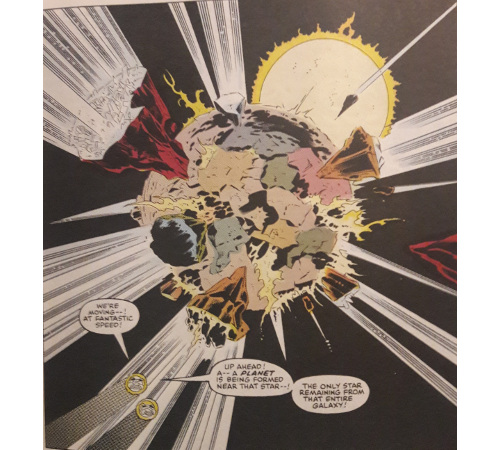
This Hunger Games-esque premise, though simple in nature, is wielded quite well by Shooter. Battles between heroes and villains actually carry weight and consequences--characters are injured, villains are captured, at least one Avenger is temporarily killed (yeah, you heard me, “temporarily”). Divisions are dug between different characters, with the X-Men deciding to leave the heroes at one point, Magneto choosing to go off on his own, Galactus soon separating himself from the other villains, and Doom trying his darndest to collect the other villains under his dominion. As the series progresses, we see less of the “heroes vs. villains” structure, allowing Shooter to nicely expand the story’s horizons and explore questions of power, godhood, and heroism.
His characterization for several heroes and villains works well, but as we will see later on, this compliment comes with a few rather large exceptions. Doom, in particular, becomes a central figure, his domineering, possessive attitude brought to the fore in every scene he’s in. Shooter’s take on the villain fits the classic mold cast for Victor von Doom cast by Stan Lee and Jack Kirby perfectly, with one fantastic scene specifically digging through Doom’s past and presenting his intentions and desires wonderfully. Instead of going along with the Beyonder’s “game,” Doom prefers to shake things up and see if he can't participate by his own set of rules. This personal story arc dominates the series and makes the Latverian ruler stand out against his fellow criminals. Magento, too, receives somewhat of an arc, though Shooter’s characterization for him seems to shift part way through the series, unfortunately diminishing his character.
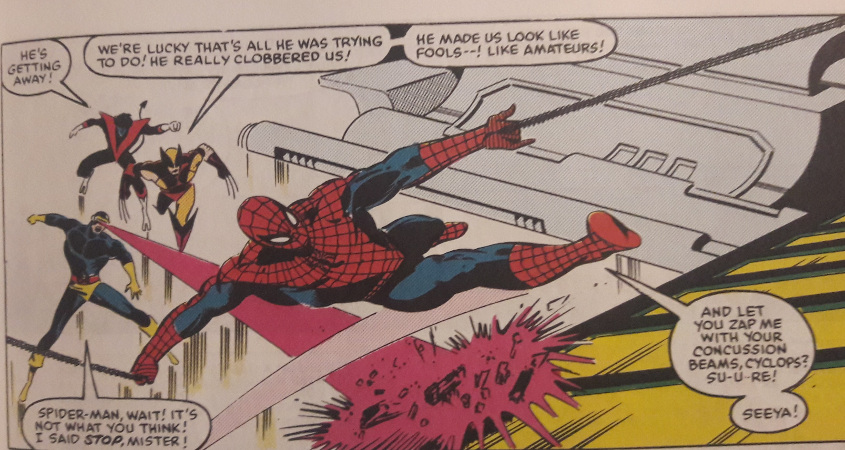
With our heroes, Shooter strives to give each one a “moment,” allowing them the opportunity to show off their magnificent abilities. Thor keeps a boulder from demolishing a base the heroes call home; the Hulk holds up an entire mountain in a sequence that may have inspired the moment in Avengers: Endgame where he hefts the crumbling HQ; She-Hulk sneaks into the villains’ base and trounces the Wrecking Crew; the X-Men hold their own against Doom’s thugs on a couple occasions; Spidey beats the mutant heroes like chumps in one scene and later discovers a new black suit which we’ll be looking at more closely in future installments. Not everyone is given equal treatment in terms of sheer awe, but Shooter works to spread out the action and heroics.
Yet, as I mentioned, some characters are treated more poorly than others. Members of the Wrecking Crew--Bulldozer, Piledriver, and Thunderball--are basically indistinguishable from one another and receive little to no characterization other than being perpetual punching bags (Spidey socks Bulldozer’s helmet clean off in one glorious panel); the Lizard vanishes without explanation after the first hero vs. villain fracas and suddenly appears in one scene, as if Shooter had forgotten about the character until then; Kang the Conquerer is vaporized by Ultron early on and doesn’t come back until the final issue. With the cast of characters assembled here, one should expect not everyone to get their fair share of dialogue and character development, so this lack is not surprising. Still, a subplot like the Lizard's random appearance in a swamp after several issues of zero "screen time" feels like Shooter slapped himself on the forehead after realizing he'd totally forgotten about poor Curt Connor's alter ego and decided to insert him back into the tale (or is that "tail"?) the soonest chance he had.
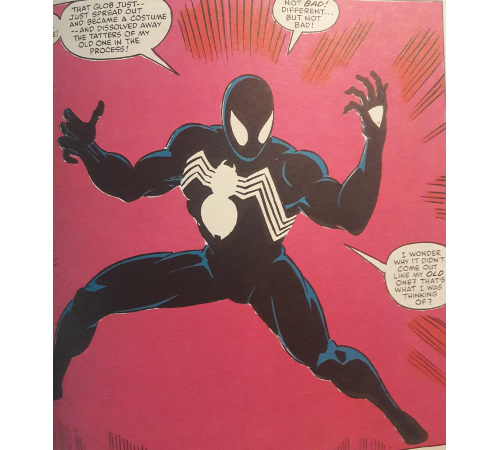
On a similar level, certain heroes either don’t develop well...or at all. Iron Man (Jim Rhodes at the time, not Tony Stark) doesn’t carry nearly as much weight as a prime Avenger should be hefting; Colossus and the Human Torch are used oddly in a subplot I’ll touch on later; and the Wasp fluctuates between an airhead who can’t go a few pages without complaining about how Battleworld has no beauty products and a supposedly top-notch hero who threatens to topple a rooftop down on Magneto’s head with her wasp stings and reminds everyone that she’s the current chairperson of the Avengers. Other characters feel like they’ve been boiled down to their “base” characteristics with little progression--the Enchantress, who spends most of her time in the comics trying to win Thor’s heart, talks a lot about winning Thor’s heart; the Molecule Man, master of all molecules, constantly reminds people that he’s the master over all molecules; Wolverine, the guy with the adamantium claws, keeps talking about cutting people up. Again, “some characters not receiving decent development” should not come as a shock, but the direction Shooter takes certain characters is surprising.
Also surprising are the new characters Shooter brings to the fold. Villains Volcana and Titania are introduced as two women taken from the Denver section of Battleworld, given powers by Doom, and set against the heroes; though Titania’s machismo becomes tiresome after a while, Volcana becomes quickly attached to Molecule Man and injects a romance subplot that’s cheesy but amusing in an oddball sort of way. And where would we be without a new hero to compliment the new villains? Also hailing from Denver is Jessica Carpenter, the second woman to call herself Spider-Woman. Why Shooter thought including a character who is a female copy of a female copy of Spider-Man was a good idea instead of introducing a brand new character like he did with the villains frustrates me slightly, but his desire to create a character instead of only utilizing classic heroes and villains makes a nice touch on the series and inserts some creativity.
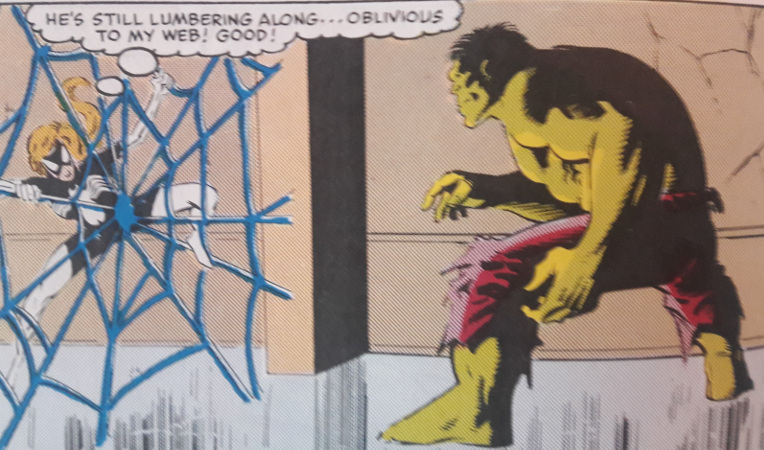
Where Shooter tends to stumble are his sub-plots. Some of these work out really well, others not so much, and still others are just plumb forgotten about. A sub-plot concerning the Hulk is wonderfully woven throughout the entire story; without directly stating it, Shooter introduces the idea that the Hulk, who had Banner’s intelligence at the start of the series, is slowly devolving into his more monstrous state. Through dialogue choices and violent actions, Shooter indirectly teases this devolution of the character over the course of several issues. Also well-written are various conflicts permeating the series--the distrust between the X-Men and the other heroes; Doom’s control over the other villains; and Galactus’ planet-eating machinations. These tensions help move the story along, but also work their way into the series’ quieter moments, filling in the slower gaps with nice characterization. Scattered throughout the series are also pages dedicated to characters wishing they were home, allowing for decent human characteristics to flood the pages that aren’t dedicated to fight scenes. Whether it’s Reed Richards and Cyclops sharing how much they want to return to their wives or She-Hulk and the Wasp missing various earthbound commodities, Shooter does well in reminding us about the “human” within the “superhuman.”
Yet for every small narrative that decently entertains the reader, Shooter slips one in that ends up feeling frustrating. Another new character, an alien healer named Zsaji, becomes an object of affection for both the Human Torch and Colossus. The Torch treats her rudely, playing little attention to what she actually wants and eventually brushing her off after he's gotten over his initial attraction. This is when Colossus comes to the rescue, but problematically, he’s already in a relationship with Kitty Pryde, another member of the X-Men currently earthbound. Try as he might to fight it, Colossus cannot combat his warring feelings forever and confesses his affections for Zsaji; this will eventually tear apart his romance with Kitty over in the pages of X-Men. The subplot feels wrong when you read it, especially considering that Shooter does little to convince you he’s presenting both the Torch and Colossus in a negative light. One or two comments from other heroes provide a glimpse into the fact that some people find the Torch's and Colossus' attraction to the healer inappropriate, but neither man is directly confronted for their feelings. You end up feeling awful for Zsaji and the treatment she receives. Bordering on creepy, this is a subplot that did not need to be included.
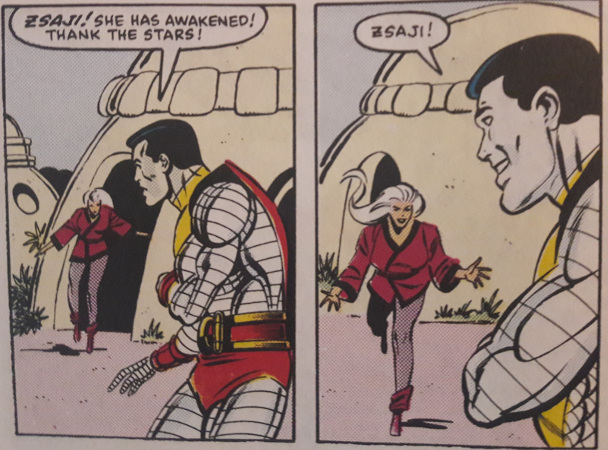
Elsewhere, Shooter tosses in various little narrative beats that seem like they could grow into something of semblance but fails to bring these pieces to fruition. A stray comment by Doc Ock makes you wonder if he’s going to rebel against Doom’s leadership, but this never happens. The Thing continually transforms back into Ben Grimm, his human form, at the least opportune moments; though this plot is explored further in the Thing’s own solo series, the issue is teased only a few times in Secret Wars and never fully materializes into a problem, making me believe it must have been some sort of editorial mandated component to serve the Thing’s own series while providing little in the way of impacting Secret War’s plot. Professor X uses his powers against Spidey at one point, erasing his short-term memory, but feels little remorse other than a comment made to Magneto; this problematic use of Xavier’s abilities is never reconciled.
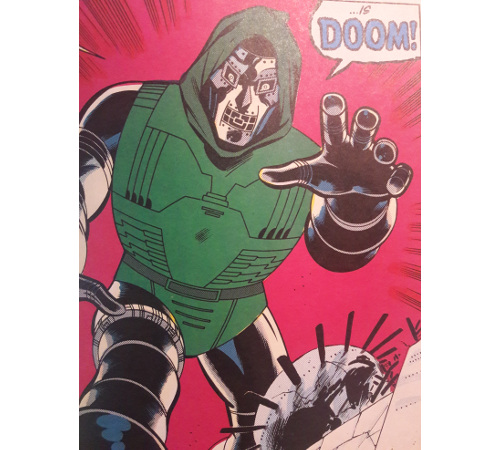
But perhaps I’m expecting too much out of Shooter. For a series intended to help sell toys, Secret Wars is remarkably dense with material and slides into deeper waters every once in a while. Incredibly dark at moments--one Avenger is seemingly murdered, Wolverine cuts off the Absorbing Man’s arm, a roomful of people are disintegrated, and She-Hulk is almost beaten to death--you wouldn’t enter the series thinking it was only meant for kids who shelled out their allowance on plastic figurines. Even with its various flaws, Secret Wars is still a credible story, with a thought-through narrative and many excellent moments. Better yet, Secret Wars is still canon within the Marvel Universe, and its surprising impact on stories immediately after its conclusion (Spidey gets a new black costume! She-Hulk joins the FF! Kitty Pryde and Colossus break up!) is only matched by how some of those effects trickle into modern tales (Spidey's costume is an alien that became Venom, Kitty and Colossus didn't reunite until Joss Whedon brought them together, etc.). Almost forty years since its publication, Secret Wars remains a remarkably readable and relevant slice of Marvel literature, far outlasting the toy line that shared its name.